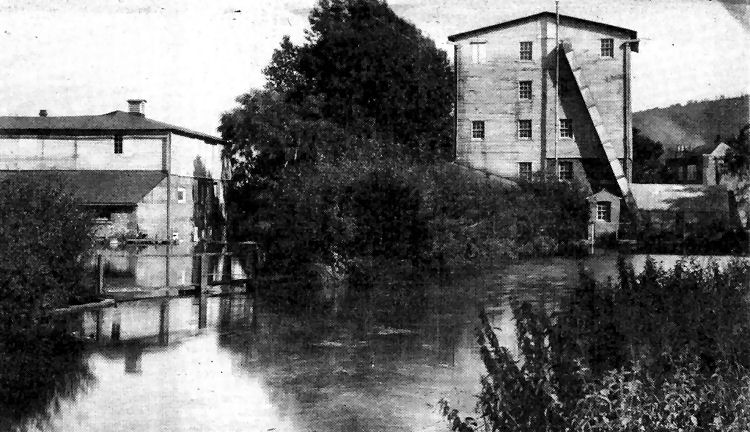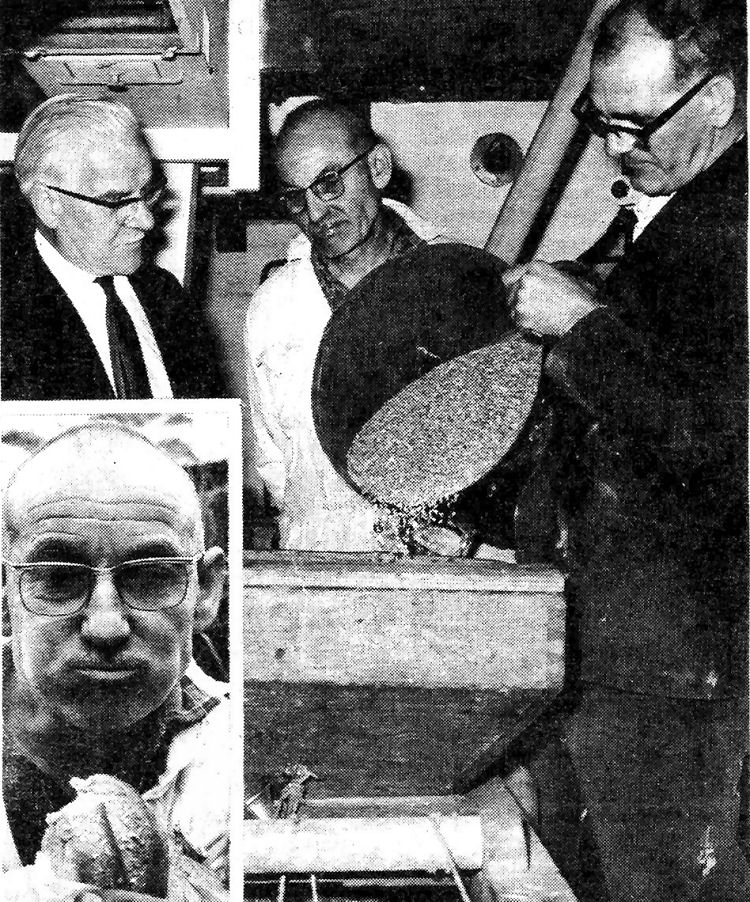Page Updated:- Sunday, 07 March, 2021. |
|||||
 Published in the Dover Express, 29 May, 1981. A PERAMBULATION OF THE TOWN, PORT AND FORTRESS. PART 186.
CRABBLE Crabble lies in the hollow on the west of Crabble Hill, its principal features when this book was written . in 1906 being a farmhouse, a corn mill, a paper mill and a modern recreation ground. The derivation of the name “Crabble" has presented difficulty to many Writers. There is no other place in the country bearing the same name. It has been suggested since this book was first published that the name applied to one of the “wells“ or springs which are to be found in the bed of the river Dour. In particular there is one near the mill at Crabble in which were noticed stones of a reddish colour as though the water was tinged with iron. The result of this is that some people thought the stones resembled crabs — the boiled variety — and it is suggested that the word “Crabble“ may be a corruption of “Crab well.“
CRABBLE FARM The centre of Crabble is the hollow where the road crosses the river, and, in the olden time, before the bridge was built, it must have been a very romantic spot, the river passing down a deep gorge, hills surrounding it in every direction, except where the river bed opens out to Buckland meadows on the one side, and the village of River on the other. The oldest institution in this hollow until recent times was Crabble farmhouse, which stood at the comer of the road that leads up to St Radigund’s Abbey. This has been described as the Parsonage farm, although it has always been understood that River, like Buckland, never had a Parsonage until modern times. The church at River was associated with St Radigund’s Abbey, and was served by the monks from that place until the Reformation. The farmstead at the corner of the road leading up to St Radigund’s might have been an outlying property of the Abbey, but whether it was ever used by the minister of River Church before or after the Reformation, there is no evidence. In the 18th century, the parsonage and lands at Crabble were in lay hands, and in 1778 were leased to Mr Thomas Lamb, who then occupied Crabble farm. In the early part of this century the farm was owned by Mr Edward Pilcher Coleman, whose residence adjoined the Lower Road a little further northward. The farm and parsonage became the property of the Pilchers, John and Joseph, in 1793. Joseph, already referred to, became the 234th mayor of Dover and took a great deal of interest in promoting the development of the South Eastern and Chatham Railway. The property passed to the Colemans by marriage.
CRABBLE PAPER MILL The paper mill at Crabble, now the property of Messrs Wiggins Teape, and Co., is a very old industry, having been used as a vat mill before the introduction of paper-making by machinery; and this was the first mill in this district into which a paper-making machine was introduced, having been set up about the same time as the one at Hertford," - those two being supposed to be the earliest in the kingdom. That machine was introduced by Mr William Phipps, nearly a hundred years ago. In Home’s Guide to Dover, published in 1819, the machine is mentioned thus: “At Crabble is an extensive paper mill, the property of Messrs W. Phipps and Sons, in which there is a curious patent machine for making paper of any length whatever.“ Mr Radford Evans, in his “Recollections of River,“ says: “Mr William Phipps was the first introducer of machines for paper-making, and I was told that the identical machine at Crabble mills, of which I had charge for some years, was the second paper machine erected in England, the first being claimed by Dickenson’s, at their water mill in Hertfordshire." The Crabble paper mill, after it passed into the hands of Messrs Wiggins and Teape, was largely reconstructed. It was burnt down on the 10th of July 1906, but rebuilt the following year. It was long worked in connection with the larger mill at Buckland Bridge but as stated earlier it was badly damaged during the last war.
CRABBLE CORN MILL The Crabble corn mill is probably older than the paper mill, although the present structure, being similar to the mill at Buckland, and those that stood at Stem-brook and St James’s Lane, off the Market Square, was probably rebuilt, with those before named, during the wars at the beginning of the 19th century, by the aid or encouragement of the Victualling Department, to furnish supplies for the troops and the Navy. In the year 1818 the mill was owned by Mr Joseph Webb Pilcher, a member of the Dover Corporation, who, five years later, was mayor of Dover. About the year 1836 this mill became the property of the Mannerings, and remained so until recent years, although their principal operations were carried on at the steam mills at Buckland. The surroundings of Crabble com mill are charming. The great mill pond on the roadside, over which swans gracefully glide, and wild water fowl disport themselves, makes a picturesque scene over which artists have lingered with unceasing pleasure for many years; But the surroundings are no longer what they were since the planners, in their wisdom, granted consent for building homes on the meadowland which ran down to the edge of the mill pond until recent years. Fortunately, a high standard of development has ensured that the area remains one of Dover’s beauty spots.
COMPLETE RESTORATION Early in 1973 Bowzells, the civil engineers, of Walmer, finished a complete restoration of Crabble mill which had been silent for over 80 years. The cost, in the region of £50,000, was met by the Cleary Foundation which was established by St Margaret’s millionaire Mr Frederick Cleary who bought the mill in the nick of time and saved it from destruction. So urgent were the repairs to the wooden structure and roof that local millwright Mr Maurice Arnold, of Deal, who supervised the job of getting the mill working again, said the structure would have collapsed in a matter of weeks had the Cleary Foundation not stepped in when it did. Another fall of snow on the roof would have caused it to cave in. Fortunately the last of the Mannering family to own the mill, Mr John Mannering, periodically had it painted and repaired, otherwise the mill would probably have been beyond redemption by 1973, despite the fact that preservation groups had had their eyes on the mill for about 20 years. In 1958 the Society for the Preservation of Rural Kent decided that the mill ought to be preserved and the county council also declared an interest in preserving a number of watermills. There was a lot of talk—but little, if any money forthcoming to do the job or take over such mills.

The Crabble Mill complex of buildings in an attractive setting near Crabble Athletic ground, as seen by a photographer about a century ago. The deteriorating corn mill was saved from collapse by the Cleary Foundation which stepped in to purchase and restore it in the early 1970s.

Pictured above is the historic moment in 1973 when grain was poured into a hopper ready for the first grinding of flour at the mill for 80 years. Pouring in the grain is Mr Martin Coyne, of Hillside Road, Dover, who assisted millwright Mr Maurice Arnold (centre), of Walmer, in the restoration, working under Bowzell’s building manager Mr Herbert Hedgecock (left), of Heathfleld Avenue, Dover. Inset Is Mr Arnold enjoying a bite of the first loaf baked from flour ground at the mill.
|
|||||
|
If anyone should have any a better picture than any on this page, or think I should add one they have, please email me at the following address:-
|
|||||
| LAST PAGE |
|
MENU PAGE |
|
NEXT PAGE | |